
Myanmar (Burmese) Ceramics
Green/white lead/tin Glaze wares
In 1984, many ceramics from the ancient burial sites of Tak/Omkoi surfaced in the antique markets in Thailand. Among them were small quantity of mainly dishes and bowls with green decoration on white ground. They were initially attributed to some unknown Thai kilns and dated to the 15th/16th century.
Subsequently, some green/white glazed tiles with molded decoration also appeared in the antique market. The tiles were similar to those found in Bago (called Pegu in the past) Shwegugyee Pagoda and Bagan (called Pagan in the past) Apeyadanar Pagoda. It was then that the antique dealers and ceramics experts noted that the glaze of the tiles was similar to those on the green on white wares. To determine the origin of the green on white wares, in early 1990s, Japanese ceramic scientists K.Yamasaki, G.Hasebe, Y.Emoto and M.Murozumi conducted scientific tests on the Tak burial samples and some glazed tiles from Bago Shwegugyee Pagoda in Bago and Bagan Apeyadanar Pagoda. The lead isotope ratios of Tak samples matched those found in glazed tiles from the Bago and Bagan pagodas. It also matched the lead sample from Myanmar Baw Hsaing mine and not that from the Thai lead mine.
The Myanmar samples also showed the presence of tin which opacified and whitened the glaze. This lead/tin composition is a low-fired lead glaze technology of Middle-eastern origin and different from the early Chinese lead glaze which does not have tin oxide.
Exactly when the glazing technology was first introduced in Myanmar?
According to Manshu (

Nevertheless, at least by the 11th/12th century, green glaze technology was introduced in Myanmar. Green glazed tiles were used on temples at the Burmese capital at Pagan (about 1044-1287). They depicted molded motifs of scenes from both the Jatakas (the stories of the previous lives of the Buddha) and the Buddha's life.
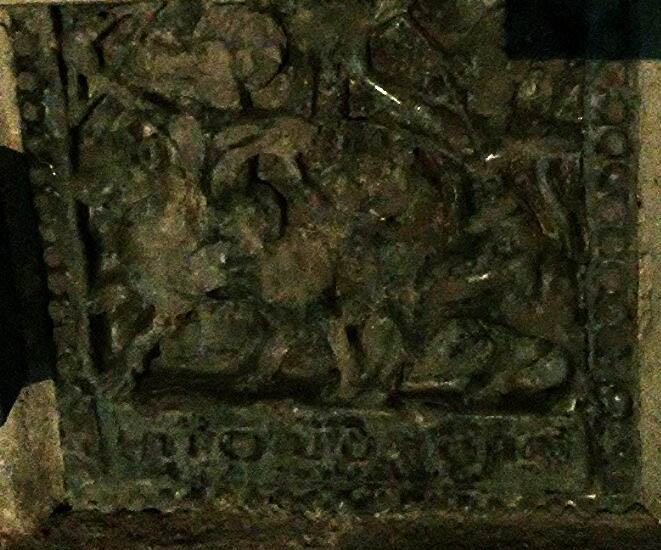
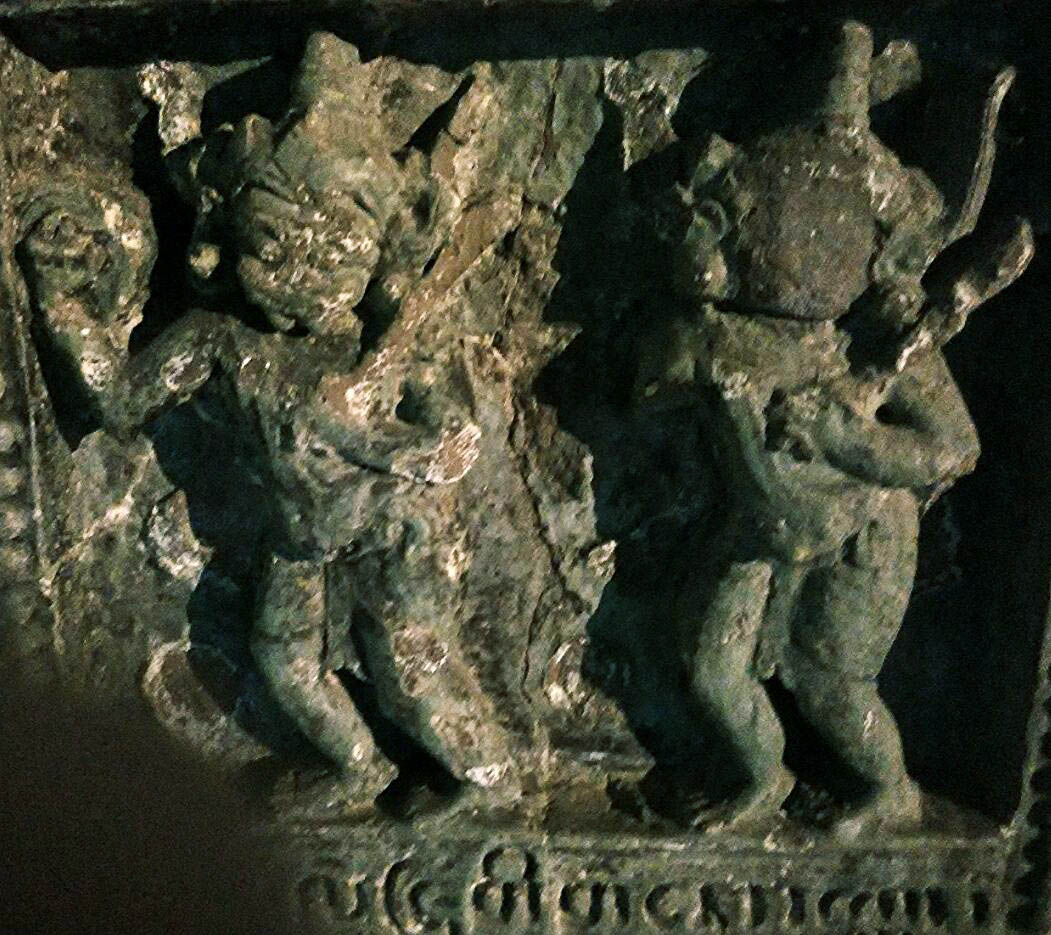
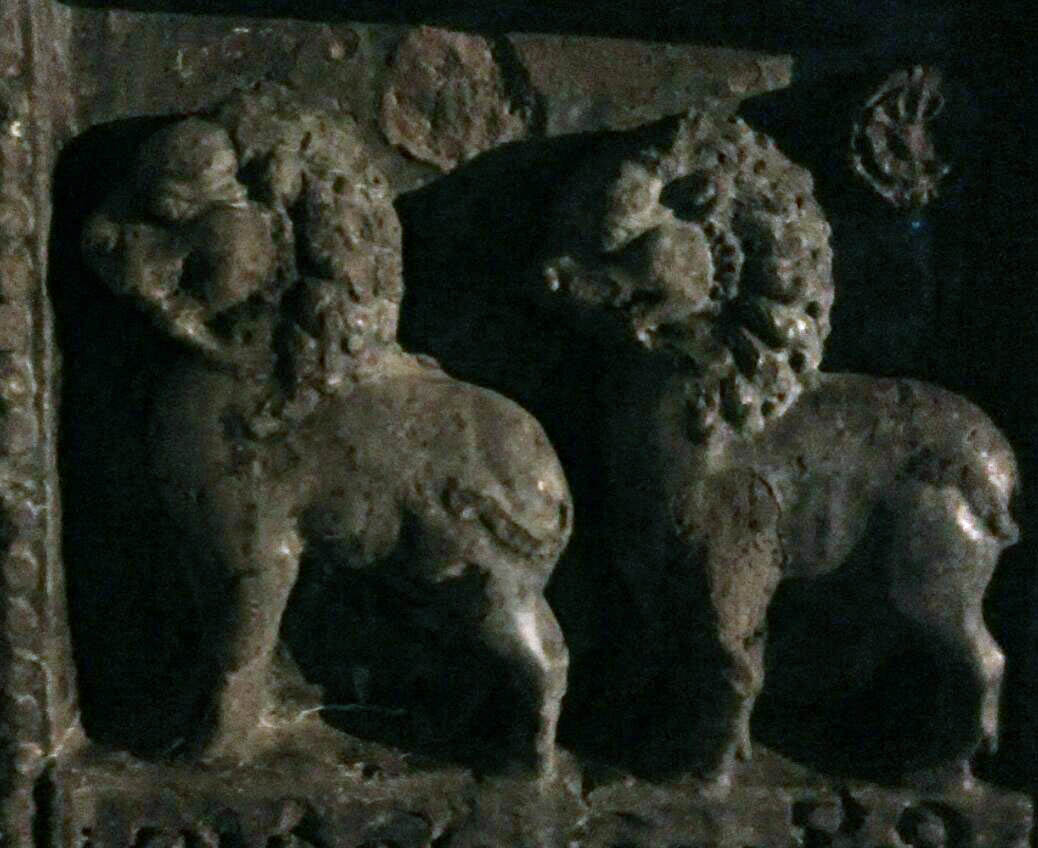
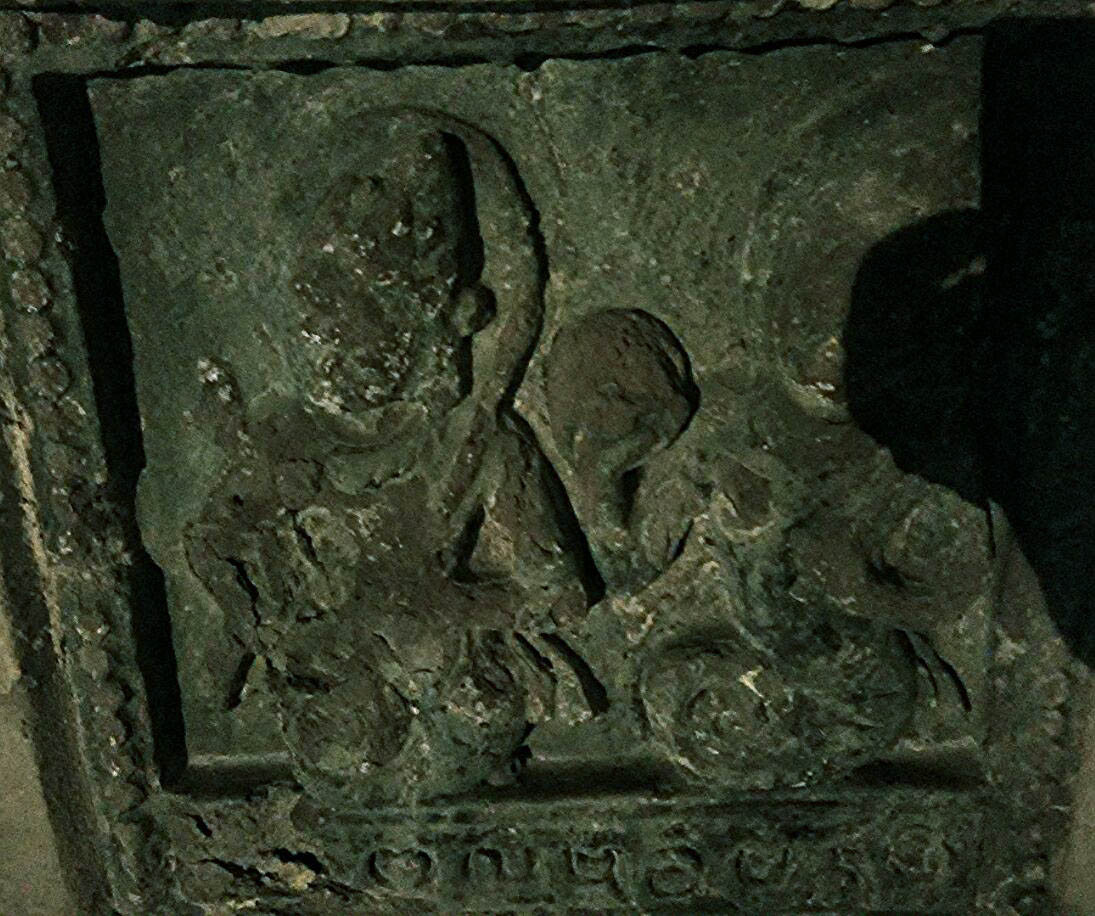
Example of Tiles with green glazed motif from Bagan Ananda temple
Those tiles with green/white glaze that surfaced during the 1980s in the Thai antique markets were traced to the Bago Shwegugyi temple. Bago was the capital of the Mon kingdom of lower Myanmar between 1369 and 1539. Hence, the tiles were likely dated to 14/15th century. Two examples are on display in the National Museum of Nay Pyi Taw.
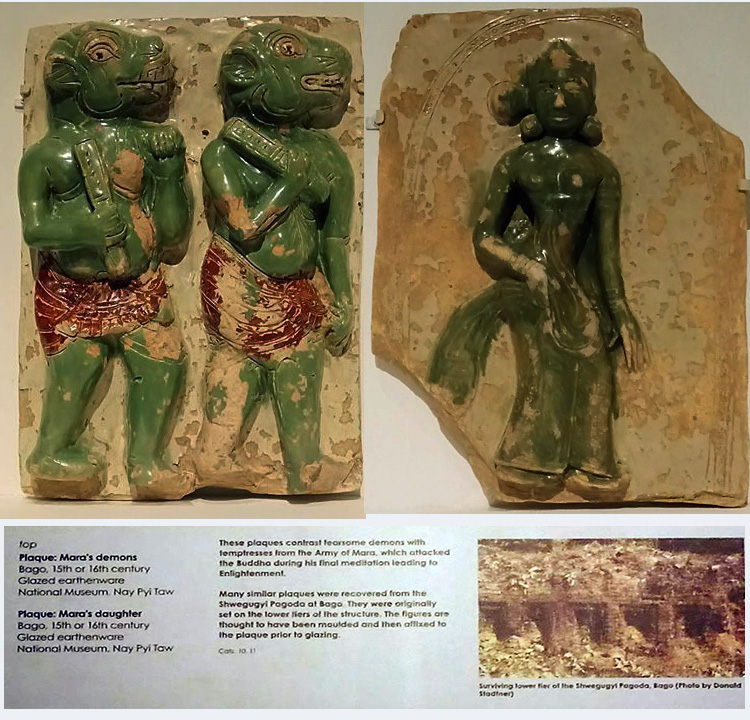
Green decoration on white ground wares from the Tak/Omkoi burial sites are generally dated to 15th/16th century. Stylistically, the motif elements such as the floral scrolls, lotus petals, peacocks and Qilin and the composition resemble those on Ming Blue and white of the same period. Close examination of the green motif reveals that the decoration is very likely drawn after application of the white glaze. Strictly speaking it is overglaze. However, the green copper oxide motif is covered by the flowing glaze during firing and appears underglaze. In many examples the decoration appears slightly raised above the white ground and certain areas of the green has a burnt darker green tone.
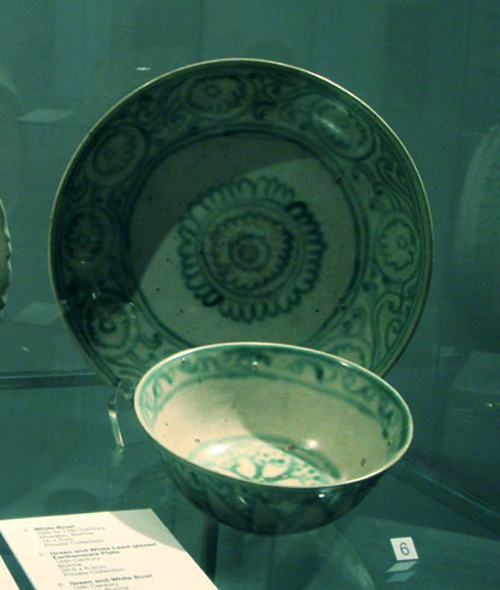 |
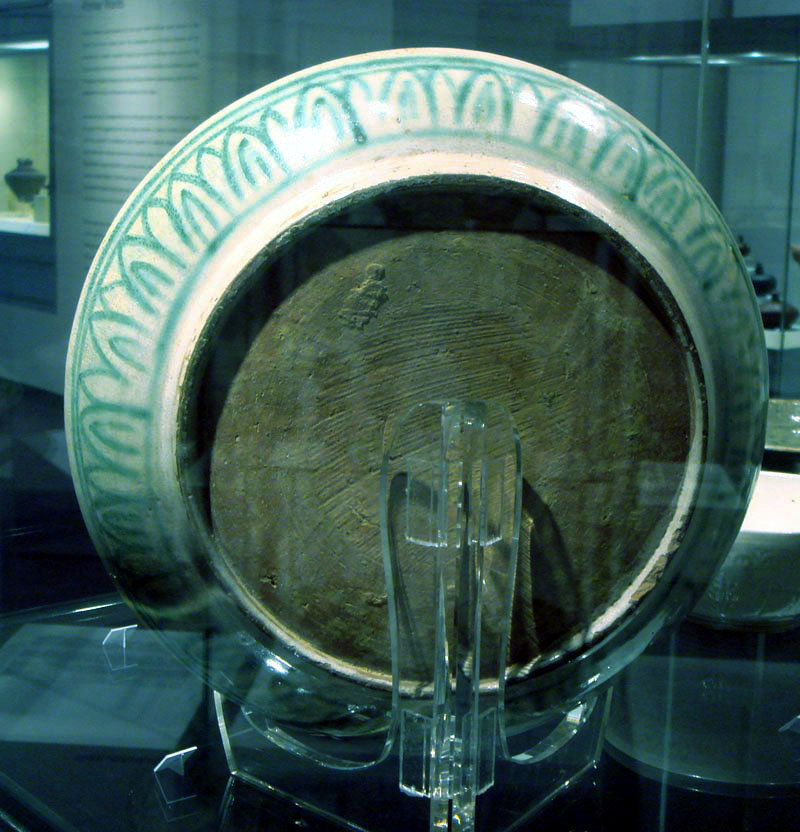 |
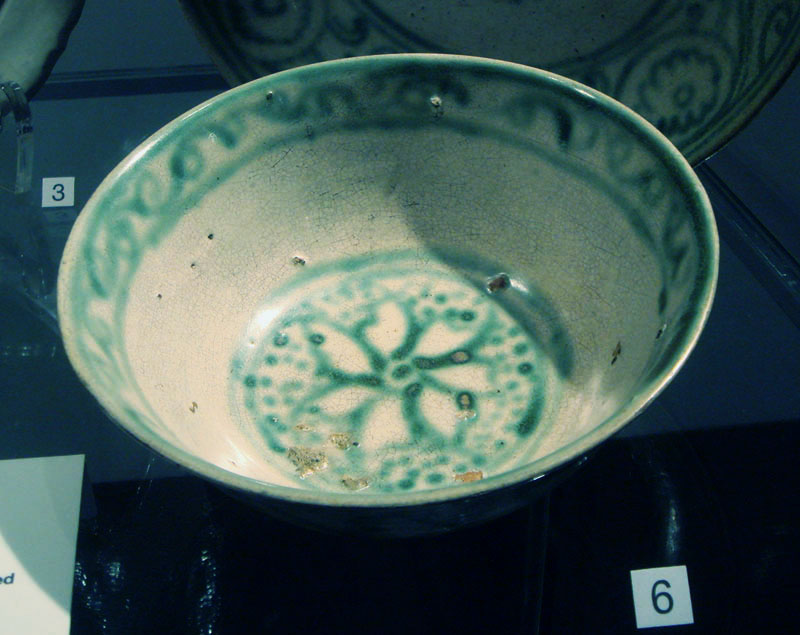 |
|
Myanmar 15th cent. Green motif on white ground plate/bowl |
|
|
|
|
|
|
|
|
| NUS Museum Exhibition. Recovered from Twante Canal |
Besides green on white ground wares, there are also those with white glaze. Many have incised decoration. They are also dish/bowls with reddish brown glaze.
Many of the Myanmar wares display some or all of the following distinctive features. There are many bowls/dishes with outer wall of the foot showing ribbed marks Many of the dishes also have a light circular mark left by the disc like support during firing. Another distinctive features found on many dishes are marks of parallel curve lines on the outer base. The exposed paste of the lead glaze ware is generally of a reddish/reddish brown colour tone.
|
|
|
|
|
|
|
|
|
|
|
Since the 1990s, innumerable ancient kiln sites have been identified in the Irrawaddy (Ayeyarwaddy) delta. Important sites includes Twante with few hundreds kilns , Lagumbyee and . Further west there are more sites in Pathein, Myohaung and Ngaputaw. The bulk of the kilns products were celadon wares. Small quantity of wares with green on white ground were found in kilns in Twante. Further up north, kilns were also discovered in Bagan and Shwebo. Archaeological evidence indicates that majority of the kilns are dated to the 15th/16th century context.
Celadon wares
The extensiveness of the area with kilns and the large number of kilns obviously indicates that ceramics production volume was huge. Besides catering to the domestic market, overseas demands must be substantial. Japanese archaeologists working from 1988 to 1994 at the Julfar and Hulaylah sites in the United Arab Emirates reported the discovery of large quantity of shards in the two sites. Julfar was one of the largest ports in the Arabian Gulf from the 14th to 16th centuries. The excavated site revealed that the lower levels consisted of many shards of Chinese celadon and white wares. Myanmar and Thai wares were found only in the upper layers dated to 15th century. The same type of celadon ware has been found, not only in the UAE, but also on the coasts of Iran, Bahrain, Oman, Yemen, Saudi Arabia, Egypt and Qatar.
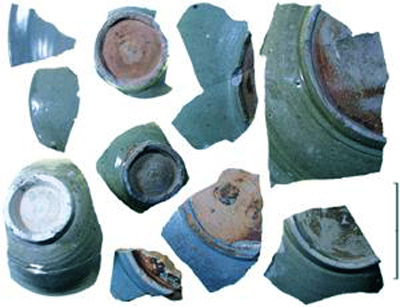
Myanmar celadon shards from Julfar

Myanmar celadon wares closely resemble their Northern Thai counterparts in terms of the characteristics of the glaze and the decoration. However, they still differ in some features such as the foot, paste and the rougher finishing with many showing messy traces of glaze patches on outer base. In the past, those who are familiar with Northern Thai celadon tend to assign them as products of unknown Thai kilns. Now with the clearer understanding of some key features of Myanmar celadon wares, we are certain that some of the celadon from the 15th century Philippines Lena cargo wreck are indeed of Myanmar origin. Indeed, if one were to review past collections of celadon wares in Philippines and Indonesia, it would not be surprising if a significant number may have to be re-labeled as Myanmar. In fact, they have also be found in archaeological site in Brunei.
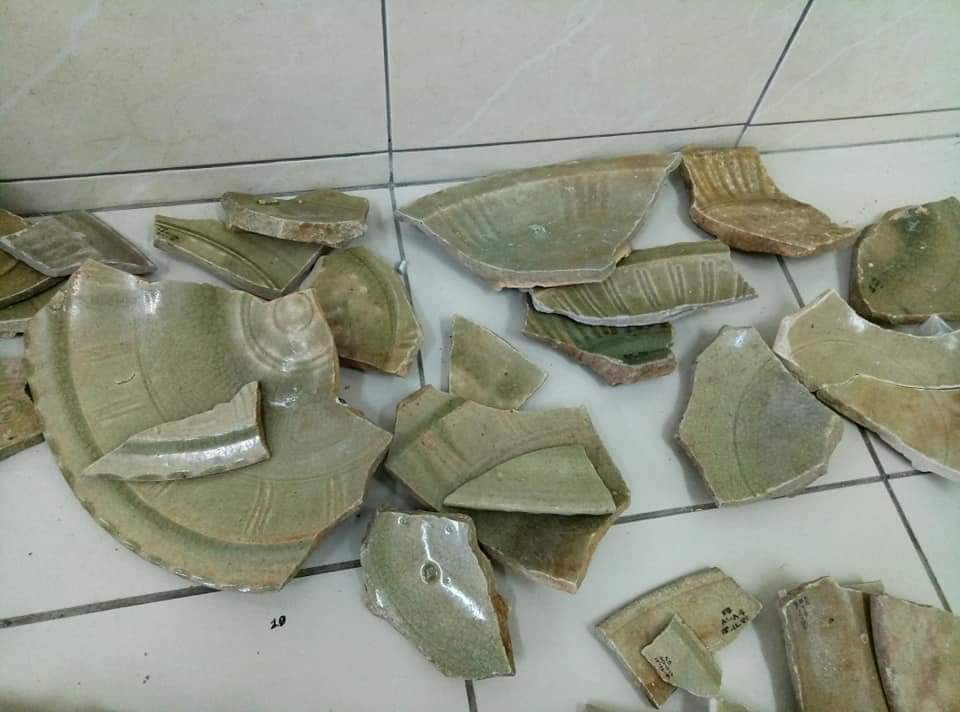 |
| Myanmar celadon fragments recovered from Brunei archaeological site (Photo credit: Hann Maidin of Brunei Museum) |
In Feb 2017, the Singapore NUS Museum held an exhibition of some sherds recovered from Twante and kilns in the vicinity such as Kangyigone, Phayagi, Zawti, Kawmu and Yadeshe. As currently archaeological information on excavated ceramics from Myanmar is relative scarce, the exhibition enables us to gain some knowledge of the range of celadon wares that were produced. Besides plates and bowls, there is a range of other vessels such as vases, stem bowl, jars and interesting figural vessel form of elephant, duck and human being. We also have a glimpse of some decorations using carved,incised, moulded and impressed techniques.
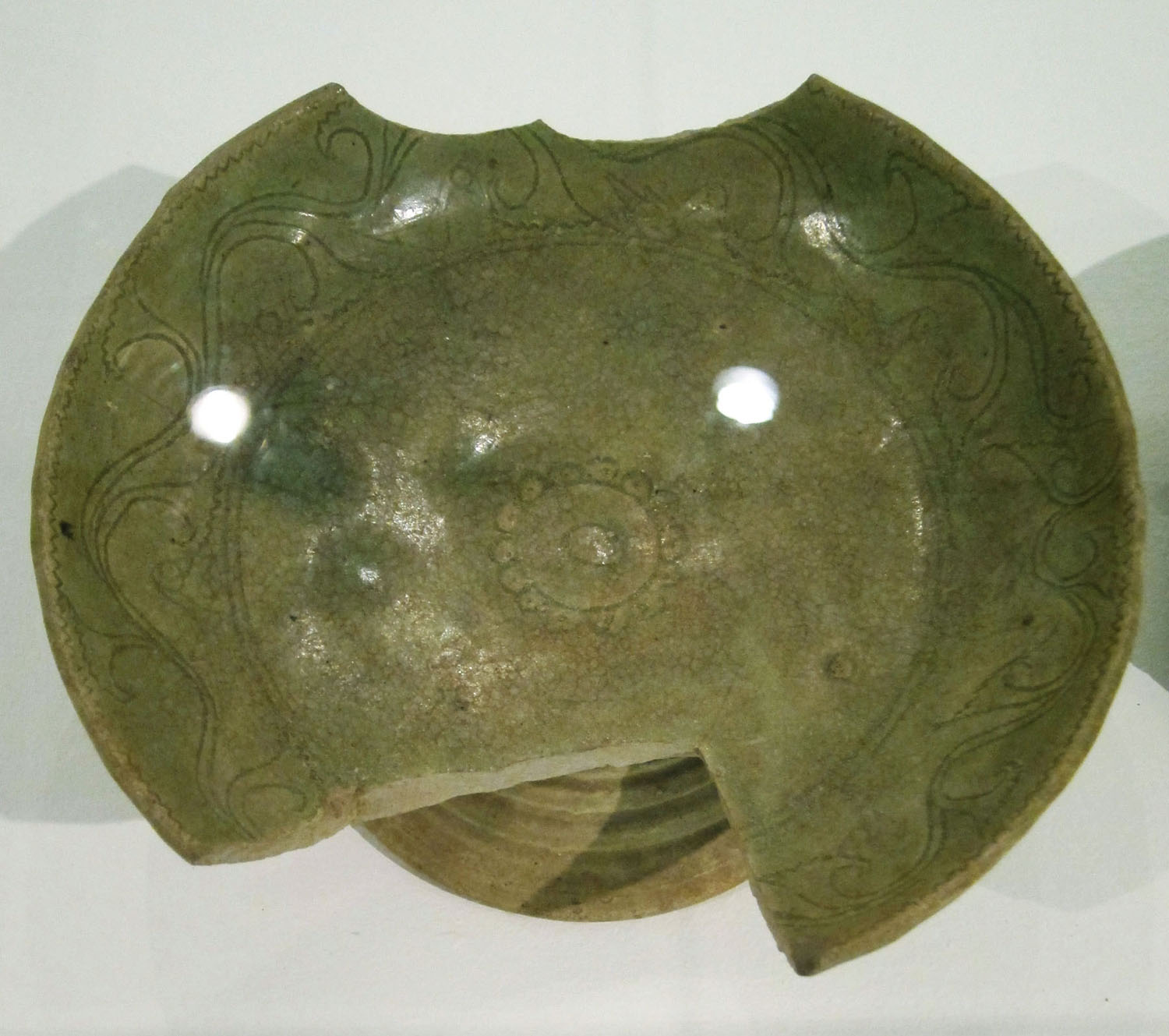 |
| Stem bowl with incised decoration recovered from Kawmu |
|
|
| Plate with decoration executed using incised, impressed/Moulded technque recovered from Kawmu |
|
|
| Plate with incised decoration recovered from Phayagyi |
|
|
| Big Jar with moulded/impressed decoration recovered from Kawmu |
|
|
| Bowls recovered from Kangygone |
|
|
|
|
|
|
| Stem bowl recovered from Twante Canal |
|
|
|
|
| Pot recovered from Kawmu |
|
|
| Vase fragment recovered from Twante Canal |
|
|
| Vase recovered from Twante |
|
|
| Head of an official recovered from Twante |
|
|
|
|
|
|
|
|
|
|
|
|
|
|
|
|
|
|
|
|
| Base of plate/bowls with incised potter's marking |
Some examples found in the antique market in Yangon.
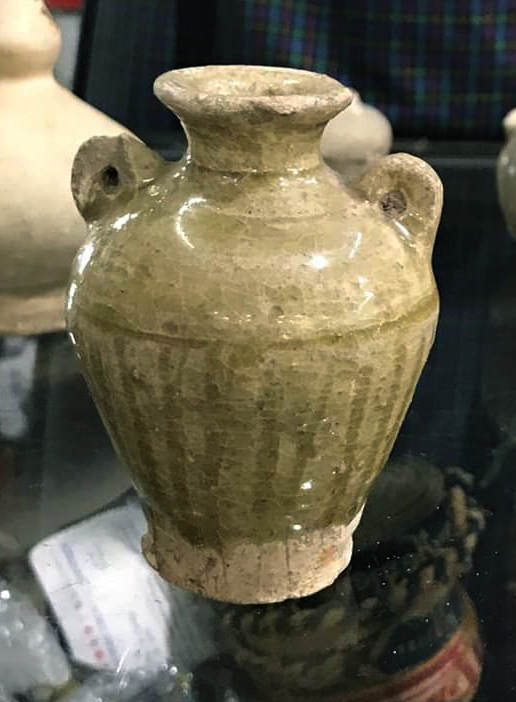 |
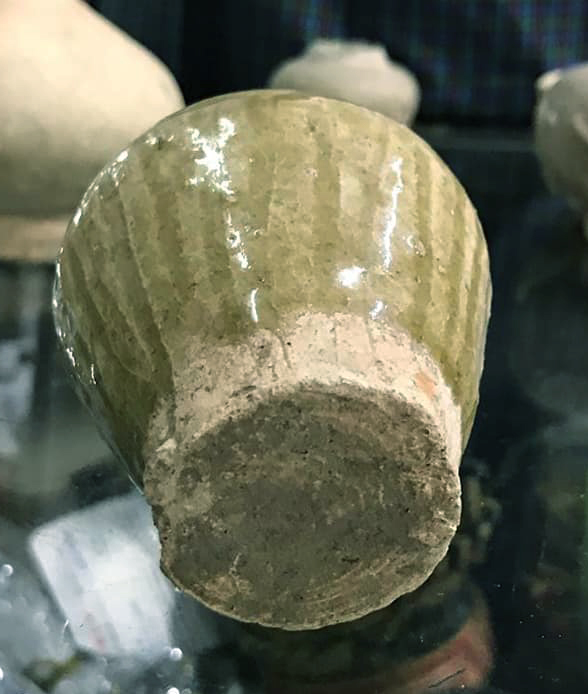 |
.jpg) |
.jpg) |
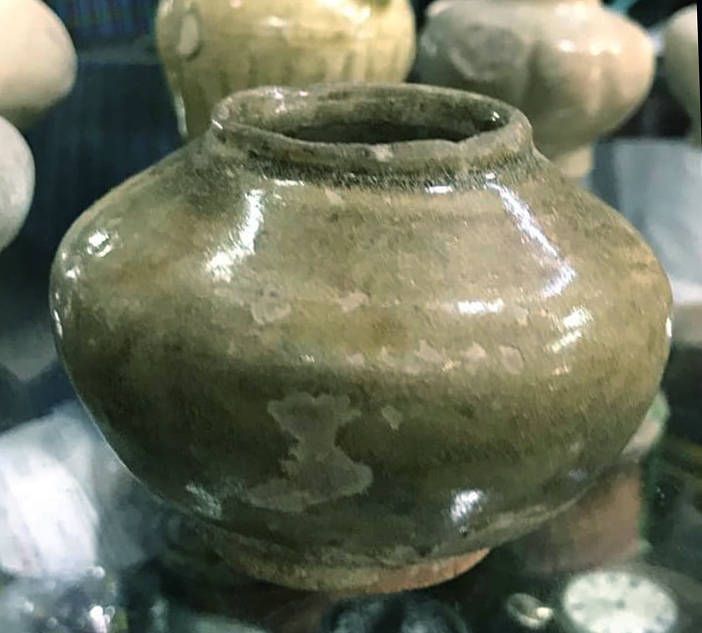 |
| Some 15/16h cent. Celadon jars |
In my collection, I also have a few pieces which were labeled as Northern Thai by the Singapore dealer whom I purchased them from.
|
|
|
|
|
|
|
|
|
|
|
|
| 15th cent. Myanmar celadon plates |
An interesting observation from the exhibition are some fragments with torquoise glaze. This is a type that is relatively unknown.
Torquoise glaze fragments Kawmu and Phayagi
Martaban Jars
The name Martaban jar was given to the name of jars which originated from Martaban (now called Moattama) from at least the 14th century. The famous Islamic traveller, Ibn Batuta, who visited Lower Myanmar in 1350 C.E. wrote: "The Princess made me a present consisting of … four huge Martaban jars filled with pepper, citron and mango, all prepared with salt, as for a sea-voyage."
Presently, the term is used indiscriminately for many big jars dated from 14th century and later. The actual place of production of the jars could be varied as Martaban was an international port. It would not be unreasonable to conjecture that jars from China, Thailand and Vietnam also made their way there as merchandise for further export through the port. As similar jars could have reached the overseas consumers from other ports along the maritime trade routes, using the term Martaban jars to suggest all originated from Martaban would be misleading.
But what is certain now is that at least a sizeable quantity of the jars were made by Myanmar potters. A Portuguese visitor to Myanmar, Duarte Barbosa recorded in A.D 1516 that "In this town of Martaban are made very large and beautiful porcelain vases and some of glazed earthenware of a black colour which are highly valued among the Moores, and they export them as merchandise." Archaeological evidences since the 1990s revealed that jars were produced in kilns near Martaban and Twante. It would not be surprising if future archaeological digs confirms more production sites in the Irrawaddy Delta and even further up in region near Bagan and Shwebo and even the Shan state.
Martaban's position as an important international port likely ceased after the Burmese attack in 1613. At that point of time, Martaban was part of the Mon state with its capital at Bago. According to Alexander Hamilton, in 1727 he commented that “Martavan in former times was one of the most flourishing towns for trade in the East, having the benefit of a noble River. which afforded a good Harbour for Ships of the greatest Burden.. But after the Barmans conquered it they sunk a Number of Vessels full of Stones in the Mouth of the River so that now it is unnavigable except for small vessels”.
However, some quantity of jars continued to be made. This was confirmed by Alexander Hamilton who further commented that : “They make earthenware there still, and glaze them with Lead-oar. I have seen some jars made there, that could contain two Hogheads of Liquor”
If the term Martaban jars is used to refer to all jars (irrespective of whether it is local or foreign made) originating from Martaban port, in all practical purpose it is almost futile for attribution purpose. For the extant pieces, we just do not know for sure that they originated from Martaban.
If we were to use the term Martaban jars, it would make more sense to restrict the term to jars made in Martaban or kilns in nearby areas such as Twante. Hopefully in the near future, with more archaeological findings we will have a clearer pictures of the features of jars made in various regions in Myanmar and hence able to use the term more accurately. As at now, at least for me I would refrain from using the term and instead use the term "Myanmar jar" for jars made in Myanmar.
The paste of Myanmar jars is usually reddish brown or red in contrast to the greyish paste found in the Thai counterpart. Some distinctive characteristics include horizontally positioned lugs on the shoulder and decoration including applied lines or dots in relief.
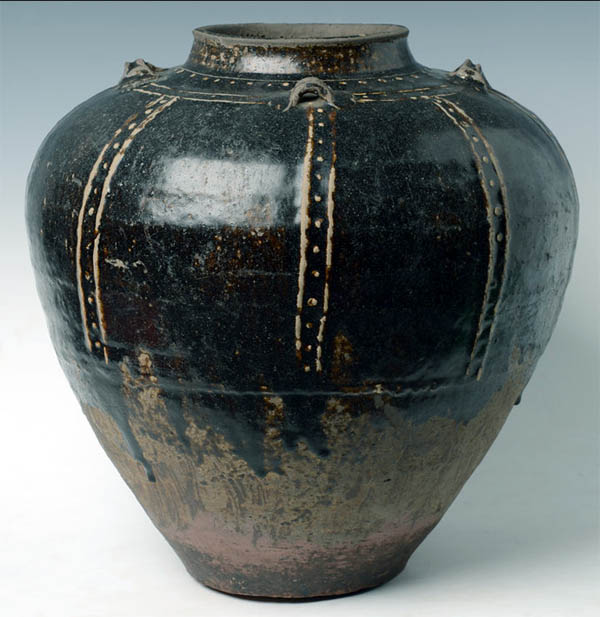 |
|
|
| 15/16th cent. dark brownish glaze Myanmar jar with horizontally positioned lugs and raised line and dots in relief |
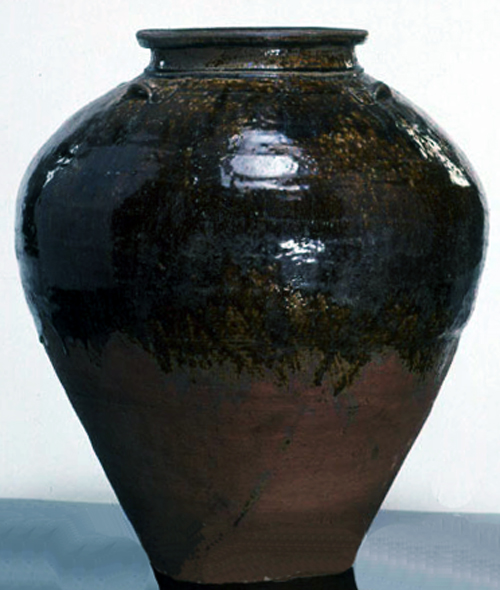 |
15th/16th cent. Myanmar jar with reddish brown paste
In the Sarawak museum, there are also some pieces of Myanmar dark brownish glaze jars. Such jars including those from China, Thailand and Vietnam were highly prized by the indigenous tribes in Indonesia and Malaysia. They are symbol of wealth and social status and used for storage of water, food and wine. In additional they were used as dowry in marriage, settlement of divorces, container for burials and etc. In the past, such Myanmar jars were erroneously attributed to Vietnam.
|
|
|
|
| Three 15/16th century Myanmar Jar in Sarawak museum |
Vietnam also produced such black glaze jars with beaded decoration. However, the lugs are positioned vertically. The glaze is also not as smooth and lustrous. The paste is also not of the reddish tone.
Vietnamese example
Concluding remarks
Based on historical texts, it is now clear that ports of Myanmar, the major ones located at Martaban and Mergui. were part of the ancient maritime trade route since at least the 14th Century. Ceramics was an important export item. Based on archaeological evidence, it is apparent that the golden period of Myanmar ceramics production was in the 15th/16th century with celadon wares and black/dark brown jars constituting the major export items.
|
Video clip of exhibition of Myanmar ceramics in Singapore NUS Museum
|
Links to some useful articles on Myanmars ceramics are listed below:
Extracts from the book Burmese Ceramics by Sumarah Adhyatman
The Martaban Trade by Pamela Gutman
Written by : NK Koh (3 Jul 2013), updated 10 Feb 2017
References:
The Ceramics of Southeast Asia - Their Dating and Identification - Roxanna Maude Brown